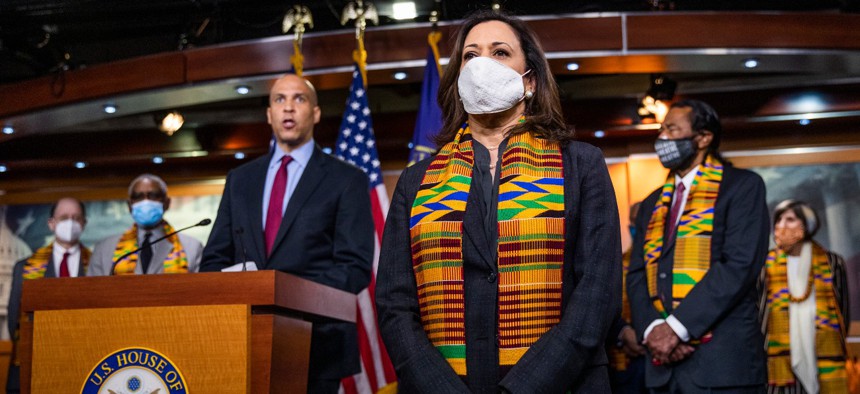Democrats Push Body Cameras for Federal Officers as Part of Police Reform Legislation
Employees have mixed reactions to proposals, which include new use-of-force standards for federal law enforcement.
Congressional Democrats are pushing for reforms to federal law enforcement, including requiring all uniformed officers to wear body cameras, as part of larger police reform legislation in the wake of nationwide protests against police brutality.
In addition to the body and dashboard cameras, the 2020 Justice in Policing Act would require federal law enforcement officers to use de-escalation techniques and use deadly force only as a last resort. The measure, introduced Monday with 200 cosponsors in the House and Senate, follows international outrage over the police killing of George Floyd in Minnesota last month. The practices of federal officers have also come under scrutiny after President Trump deployed thousands of them around the country to quell mostly peaceful protests taking place in dozens of cities.
“We are here today with common-sense solutions, at least at the federal level, to hold police accountable,” said Sen. Kamala Harris, D-Calif., who helped introduce the bill in the Senate.
Police forces have increasingly turned to body cameras to boost transparency and accountability for officer actions, but there is no current requirement for officers at the federal level. The Border Patrol has experimented with body cameras, completing two pilot programs to test the technology. It has not adopted their use, though it issued a request for information for body cameras last year.
In addition to body-worn cameras, the legislation would require federal police vehicles to have dashboard cameras mounted. The bill would task the Government Accountability Office with launching an investigation into the federal officers’ training, vehicle pursuits and use of force. Federal law enforcement personnel would face a ban on using chokeholds and similar tactics to restrain individuals they are detaining. The measure would require bias and duty to intervene training for federal officers, ban “no-knock warrants” in federal drug cases and change federal personnel’s use of force standard from when it is “reasonable” to when it is “necessary to prevent death or serious bodily injury.”
Larry Cosme, president of the Federal Law Enforcement Officers Association, took issue with many provisions of the bill and said reform efforts would be more effective if stakeholders were engaged in the drafting process. On the issue of body cameras, Cosme said he would support it for some officers but not agents in investigatory roles who deal with confidential informants. He suggested U.S. Capitol Police and the Interior Department’s Park Police begin using the cameras as a pilot. Cosme added FLEOA was “totally against” changes to the use of force standards for federal officers.
“What’s next, we're going to be giving out flowers to anyone attacking an individual?” he asked. “At the end of the day if you’re meeting a deadly force threat, you have to deploy deadly force.” Cosme added, “You’re talking split second decisions.” He further suggested federal officers should not be subject to a “complete ban” on chokeholds, noting every situation is different and they are sometimes necessary. Their use has faced severe criticism after police officers deploying the tactic killed unarmed individuals in several high-profile incidents caught on video.
Cosme, a federal agent for nearly three decades, most recently with Homeland Security Investigations, supports more training for federal officers throughout their careers. That can include deescalation tactics, he said, but they should not be the primary focus.
Joe Murphy, president of American Federation of Government Employees council that represents Federal Protective Service officers at the Homeland Security Department, said he and the officers he represents are eager to use body cameras.
“I am in support of [officers] wearing them and our members have asked for them over the years,” Murphy said. “Some have even volunteered to pay for their own, [but] we are currently forbidden from wearing them or having one mounted in our patrol cars.”
Murphy added certain concerns about privacy in confidential spaces and with regard to personal phone calls and other conversations could be easily addressed in legislation.
A DHS advisory panel found in 2015 that Customs and Border Protection should consider outfitting its law enforcement personnel with body cameras. The panel also suggested use of force changes, prohibitions on when to deploy firearms and a large surge in internal affairs investigators. CBP has implemented some of those reforms—leading to declines in shootings by officers—but has resisted others.






